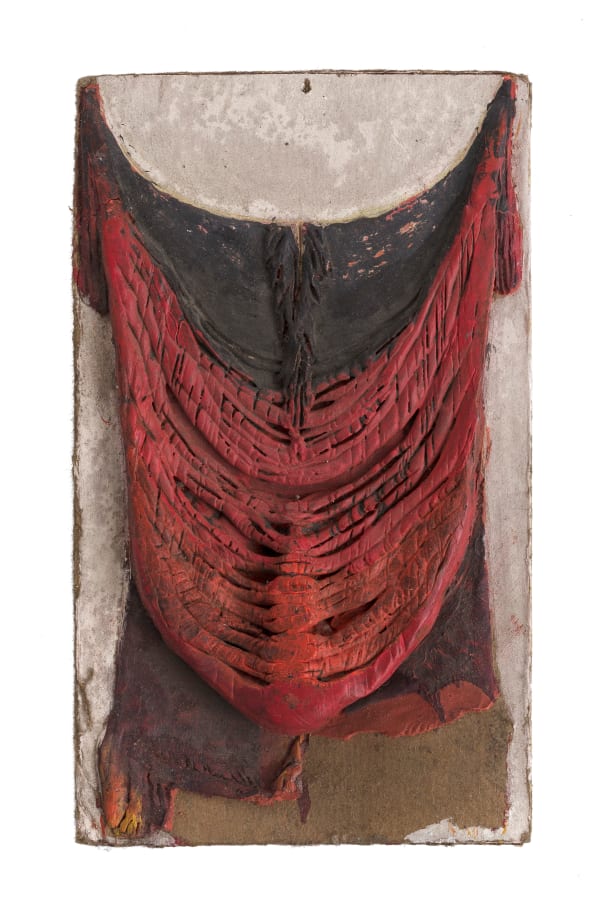Maryn Varbanov: Relics
Maryn Varbanov (born 1932, Bulgaria – died 1989, Beijing) was a powerful but often overlooked fixture of the China ’85 New Wave Movement. He actively contributed to the greater Avant-Garde dialogue both as a prolific artist and a beloved teacher, influencing artists such as Gu Wenda, Liang Shaoji, and Shi Hui as well as the young curator, Hou Hanru in their formative years.
In 1951, as one of the first exchange students in liberated China, Varbanov studied at the Central Academy of Fine Arts, and went on, against the laws of the day, to wed his translator and minder, the illustrious Madame Song. The couple soon went on to live and work between Paris and Sofia, returning to the mainland only after opening up in the early 1980s.
Varbanov went on to found the Institute of Art Tapestry Varbanov (IATV) at the China Academy of Art in Hangzhou. He pioneered the genre of “soft sculpture” – now known as “fiber art” – by subversively re-appropriating the decorative art of tapestry and interrogating its underlying architectonic structure. Underscoring the identity of tapestry as an imported good, the artist drew from both Chinese and Eastern European trade histories. He interlaced Hellenic, Slavic, and Ottoman knitting sensibilities with traditional Chinese silk and wool weaving and inadvertently helped to lay the foundation for installation as an art form in China. Throughout his artistic practice, his personal life, and his pedagogy, Varbanov delicately negotiated between East and West; local and international; tradition and the avant-garde embodying duality itself as an essential feature to his life and work.
Presented here are Varbanov’s plasticine models, which were produced in Europe in the 1970s and acted as sketches for larger fabric works. Some of these larger fabric works were realized while others remained merely models. In these small enigmatic sketches we see the artist’s overlapping sensibilities – both modern and orthodox, organic and galactic – that have since seeped into the works of younger artists in China.
Varbanov’s tradition is alive and well in today’s China Academy of Art. His spirit and creativity continues to nurture a new generation of artists who preserve and innovate as they achieve breakthroughs along the way. The trajectory of its development started with Varbanov’s collaboration with the Hangzhou Carpet Factory, and then the establishment of the IATV (Institute of Art Tapestry Varbanov), and then it took on environmental art and public space, before developing into today’s Fibre and Space Art Workshop and the Department of Sculpture. His initial idealism and creativity were preserved in this process. A lot more work needs to be done to study the context and history of the development of his art, from the sowing of the idealist seeds to today’s fruition. His story hasn't come to an end. Many more questions demand an answer and we find ourselves in the constant process of rediscovering him.
–Sun Zhenhua
Today when we revisit his sketches, his thinking and his models, we are again rewarded with new knowledge and discoveries. He will remain our guide and mentor forever. Maybe in every creative act of ours with a hint of boundary crossing, we could always detect a trace of him as the master of boundary crosser. The spirit of Varbanov will live on!
–Shi Hui
Our society has produced thousands and thousands of artists. The fact that we’re studying Maryn Varbanov among all artists means there’s something to him that is extraordinary. From the perspective of historiography, we need to position him in his immediate surroundings, in relation to the other worlds. … In turn it will render more visible the 1980s we have been trying to decipher as well as the Avant-Garde, and China back then.
–Lv Peng
The Avant-Garde’s most important impact on the Academy was an institutional and creative enlightenment. In this sense, the Varbanov team was another kind of enlightenment, that of the ontology of the language of art and of art forms. It offered a contemporary creative approach marked by the deployment of shape and structure as its major forms, which is alternative to the traditional educational system that emphasized realism and painting. The creative work in the tapestry led by Varbanov achieved the modern transformation of traditional culture and techniques. This was an approach well ahead of its time, yet the innovations of the Avant-Garde did not fully acknowledge this trend, or the significance of this framework.
–Yin Shuangxi











